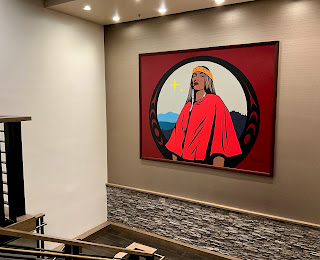Ms. Janes Fine Dining in Fife Washington, is where culinary excellence meets cultural inspiration. Drawing from the rich landscapes and traditions of Coast Salish culture, their exquisite menu features premium steaks, seafood, pasta, and a curated wine list that promises a remarkable dining experience.
Thursday, August 29, 2024
ARTIST REFLECTION on Ms. Jane’s Fine Dining
Sunday, August 18, 2024
"Invisible Problems Well Documented": An Art Book to Call to Action (Work In Progress)
"Invisible Problems Well Documented": An Art Book to Call to Action (Work In Progress)
"Invisible Problems Well Documented" is more than just an art book; it’s an evolving call for action in a world often overshadowed by pressing issues. This book uses art to illuminate problems that, while urgent, are not beyond our capacity to address. It serves as a reminder that although we may sometimes ignore these issues, we have the power to open our eyes, hearts, and minds to effect meaningful change.
The United States stands at a critical juncture, with today’s choices shaping future generations. This book captures key moments that define our era, illustrating times when we have chosen to observe rather than act, to comment rather than contribute. Yet, within these pages lies a message of empowerment: acknowledging that we are not powerless and that even small actions can bridge divides and heal wounds.
As an artist, I have opted to move away from the noise of social media, focusing instead on art as a more enduring medium of communication. The subjects in this book arise from conversations with friends, touching stories, and significant events shaping our collective experience. Each image reflects our shared humanity, highlighting struggles and celebrating the resilience that defines us.
Invisible Problems Well Documented extends the themes explored in Guidance Through an Illustrative Alphabet, capturing pivotal moments of our time through art. Invisible Problems Well Documented addresses visible but often ignored issues such as Missing and Murdered Indigenous Women and Girls (MMIWG), COVID-19, gun violence, U.S. Presidents, social media, homelessness, money, environmental neglect, tribal relations, hunger, extremist behaviors, dishonesty, and concerns about children. This avoidance of critical issues is a tradition embedded in American ideals. Despite many thoughtful changemakers striving for positive transformation, those who spoke most forcefully for truth and unity were frequently silenced due to corporate greed or resistance to efforts for racial, sexual, or gender inclusion.
In addition, IllumiNative, a Native women-led organization grounded in core Native values, has invited me to write an essay on “100 years of Native American U.S. Citizenship.” This essay connects my artist statement with the themes in Invisible Problems Well Documented, linking historical struggles for recognition and rights with contemporary issues.
Invisible Problems Well Documented is not merely a critique but an ongoing work in progress. It is a vision of potential, calling us to embrace compassion over indifference, action over apathy, and unity over division. The book encourages readers to look beyond the surface, recognizing that change starts with awareness and grows through collective effort.
Within these pages, you’ll find a mix of political insight, spiritual reflection, and nostalgic connection, all imbued with hope. The problems documented are not permanent; they are challenges awaiting solutions that lie within us. As an evolving project, this book serves as a reminder that while the road ahead may be difficult, it is also filled with opportunities for meaningful change. Through awareness, creativity, and compassion, we can turn today’s challenges into tomorrow’s triumphs.
My Alphabet Understanding with an Upcoming Essay on the way....
Thursday, August 1, 2024
The Power of Nostalgia and the Legacy of Germination Mother Corn
The motivation behind why we hold on to inanimate objects that keep us safe or give us hope is often rooted in nostalgia. These objects remind us of the innocence we once had and help us understand what we've lost over time. For example, a figurine I have traveled with since I was a teenager—a kachina—has become a symbol of my innocence and an anchor to my past. This kachina also represents my journey of progress as I travel, teaching my food knowledge and artistic expressions to Native youth across the country. The significance of this kachina in my life is tied to a rich history filled with both sadness and inspiration, which I would like to share with you.





























.jpg)

